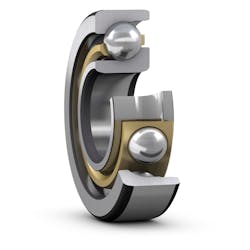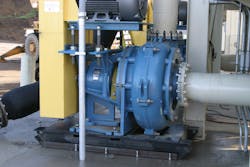Practical methods in rotating equipment vibration analysis
In processing industries, there are several challenges that can lead to flow-induced issues, ranging from the degradation of a piping structure to the misapplication of a pump. Flow-induced vibration can come in many forms due to the various configurations of process piping, pumps, sumps and tanks that have an impact on the hydraulic applications.
Typically, data collection routes are created to help monitor and identify machine health changes over time, including conditions that create a flow-induced vibration. It is important to determine whether the root cause is due to suction or discharge at the impeller and housing location. After this is determined, the application or component causing the issue — such as an impeller, casing, bearing, etc. — needs to be identified.
For example, the initial processing steps in the paper industry can be extremely abrasive as raw materials are converted into paper. Often, sand from the tree harvest is present in wood pulp. This can lead to degradation of the pump housing or volutes in certain application areas — either of which then creates a flow-induced issue.
Another challenge is that pumps are often outsourced to third-party repair centers or rebuilders who may not be familiar with the intended use of the machine or, in the worst case, may not follow best practices for pump overhauls. An improperly installed impeller can cause shaft or housing damage and failure over time.
Besides the risk of lost productivity, safety concerns and the environmental impact that comes with pump failures in fluid processing are both relevant. Pump failures — particularly in the oil and gas industries — can be dangerous to human health, while also seriously detrimental to the environment.
Bearing healthBearings can be contributors to overall pump vibration. Bearings that are improperly specified, stored, installed or maintained can significantly affect pump operations in processing plants. Bearing lubrication can also contribute to pump failure — whether it is too much, not enough, the wrong type of lubricant or the wrong application frequency. When a bearing begins to fail, it may start turning on the shaft. When the shaft begins to fail, the impeller may twist off.
If the pump was not assembled properly and there is not enough clearance from the backplate on the volute, it can cause poor suction and create unwanted vibration from the beginning of operation. Bearing and flow issues are unrelated to the pumping application but manifest in the vibration signature in the same frequency range.
Setting up a vibration analysis program
Companies interested in monitoring machine and pump health through vibration analysis should start by determining the criticality of all their assets. Which pumps can run to failure without consequences and which can pose significant cost and/or safety issues upon failure? It is important to identify specific collection points on an asset where the vibration collection will provide the most accurate indication of machine health. These points will not be the same on every asset.
Rpm and the number of vanes in a pump play a key role in identifying flow-induced vibration. For example, a six-vane pump should create vibration at six orders of running speed. Analysts should look for variations in the vibration signature that are uncommon, such as a raised noise floor in the spectral data, modulation of the time capture or higher frequency that appears to be random noise — typically in an acceleration spectrum with and frequency setting at 300 kcp or 5 kHz).
Proper use of sensors
When conducting vibration analysis, it is critical to maintain the consistency of the data. Techs often use a handheld device that is carried throughout the plant to monitor and record vibration. The sensor should be placed in the same location on the rotating equipment, which should be clearly marked on the asset. This allows for consistency between data collection intervals. Ideally, the same sensor would be used each time since different sensors may not measure vibration at the exact same level, and the calibrations can be slightly different. This is true even if they are the same type of sensor.
Proper mounting of the sensor also plays a key role in consistency. Portable sensors typically have a magnet-based mount that the analyst moves from asset to asset. If the sensor is not set on a solid base and is allowed to move, it may give an inaccurate reading. Ideally, sensors should have the same mounting at each location, but that may not always be practical from an operations perspective.
Some applications make it difficult to mount the sensor in certain locations, so an analyst may pick certain sizes of sensors and magnets to acquire data at all of the locations. Additionally, if a vibration program is being conducted by more than one analyst, it is essential they receive the same initial training to ensure consistency and commonality between data collection.
Mobile apps complement data collection
The portable sensor provides instant feedback via the app. If help is needed, some companies like SKF offer in-app communications that connect users to expert analysis, advice and diagnostic reports. These tools and technologies can also complement a broader existing vibration analysis program, especially in asset-intensive plants where resources may be limited.
Optimizing pump performance
Digitalization and technology developments are rapidly becoming key drivers in the manufacturing industry. The internet of things (IoT) is connecting machines with big data, which offers new, actionable insights into machine performance with more opportunities to improve efficiencies.
Condition monitoring with vibration analysis is essential to ensure a pump is running on the curve for its optimal performance. Having the ability to cross-functionally compare vibration, temperature and oil analysis allows operators to get an overall snapshot of machine health. Connecting, collecting and correlating data offers a new way for people to interface with machines to increase efficiency and productivity.
Companies like SKF are not only using big data to help plants monitor and analyze the health of their machinery, but they can also help original equipment manufacturers (OEMs) improve machine design. For example, data insights can be shared with OEMs to enhance pump design — recommending a different bearing or seal — that could alleviate a specific design challenge experienced on a global scale.
This type of sophisticated data mining not only provides insight that drives strategic, operational decision-making but can also optimize product design and development.
ROI of vibration analysis
Setting up a proactive vibration analysis program can save companies thousands of dollars. Identifying a flow-related issue before damaging the internals of a pump can prevent a $3,000 repair from turning into a $25,000 repair. Factoring in the loss of productivity that can also occur when a pump fails further contributes to the return on investment (ROI).
Companies that want to use digitalization to maximize performance, reduce costs and be more competitive — but do not necessarily have the resources or expertise in-house — can turn to third-party experts to transform their business. New fee-based business models designed around performance criteria allow companies to approach machine maintenance, performance management and procurement in a different way.
Pay-for-performance contracts, such as SKF Rotating Equipment Performance, can help plants mitigate reliability issues, minimize unplanned maintenance and repairs, maximize equipment availability and reduce overall operating costs.




